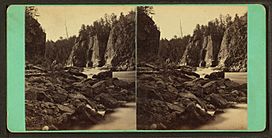Ripogenus Gorge facts for kids
Quick facts for kids Ripogenus Gorge |
|
|---|---|

1870s view of Ripogenus Gorge
|
|
| Length | 10 miles (16 km) |
| Width | 700 feet (210 m) |
| Geography | |
| Location | Northeast Piscataquis, Piscataquis County, Maine, USA |
| Rivers | West Branch Penobscot River |
The Ripogenus Gorge is a deep, rocky canyon in Maine, USA. It was carved by the West Branch Penobscot River. This amazing gorge is about 10 miles (16 km) long. It is also about 700 feet (213 meters) wide.
Long ago, the Ripogenus Falls controlled the water flowing from Ripogenus Lake. But in 1916, the Ripogenus Dam was built at the start of the gorge. This dam created a large reservoir for making electricity. This new, bigger lake includes what used to be Chesuncook Lake, Caribou Lake, and Moose Pond. People often call this whole big lake "Chesuncook" because it was the largest part.
The gorge is a special place to see the bedrock of the Maine North Woods. Usually, thick layers of glacial till (dirt and rocks left by glaciers) cover the bedrock. But here, the rocks are exposed. Scientists have studied the rocks in the gorge. They found a type of rock called the Ripogenus Formation. These rocks formed in shallow ocean water a very long time ago.
History of Ripogenus Gorge
For many years in the 1800s, people harvested Spruce trees along the West Branch Penobscot River. They would float the cut logs down the river. The logs traveled through the gorge to sawmills. Some mills were as far away as Bangor, Maine.
Rivermen, who guided the logs, changed the gorge. They used dynamite and built timber structures filled with stone. This helped stop logs from getting stuck in big piles called log jams.
Building the Ripogenus Dam
Work on the Ripogenus Dam started in 1915. Its main purpose was to create hydroelectricity. This power was needed for a large paper mill in Millinocket, Maine. The dam is 92 feet (28 meters) tall and 704 feet (215 meters) long. It holds back the largest water storage area ever built with private money.
Electricity is made by sending 2,400 cubic feet (68 cubic meters) of water per second through a long pipe. This pipe, called a penstock, goes around where the falls used to be. For many years, wood for the paper mill was sent over the dam using a special chute. But in 1971, the Great Northern Paper Company started using trucks. They used the Golden Road to carry the wood to the mill instead.
Whitewater Fun in the Gorge
Today, when water is released from the dam through the penstock, it creates exciting whitewater rapids in the gorge. This makes it a very popular spot for whitewater rafting and kayaking.
Rafters and kayakers paddle between tall rock cliffs. They go through rapids with fun and sometimes scary names. Some of these include:
- Exterminator Hole (Class IV)
- Staircase (Class IV)
- Fist of God
- Big Heater
- Little Heater
- Troublemaker Hole (Class III+)
- Cribworks (Class V)
- Turkey Chute
- Final Chute
- Postage Stamp Rock
- Bonecruncher (Class III)
The "Class" numbers tell you how difficult the rapids are. Class V is the most challenging!

